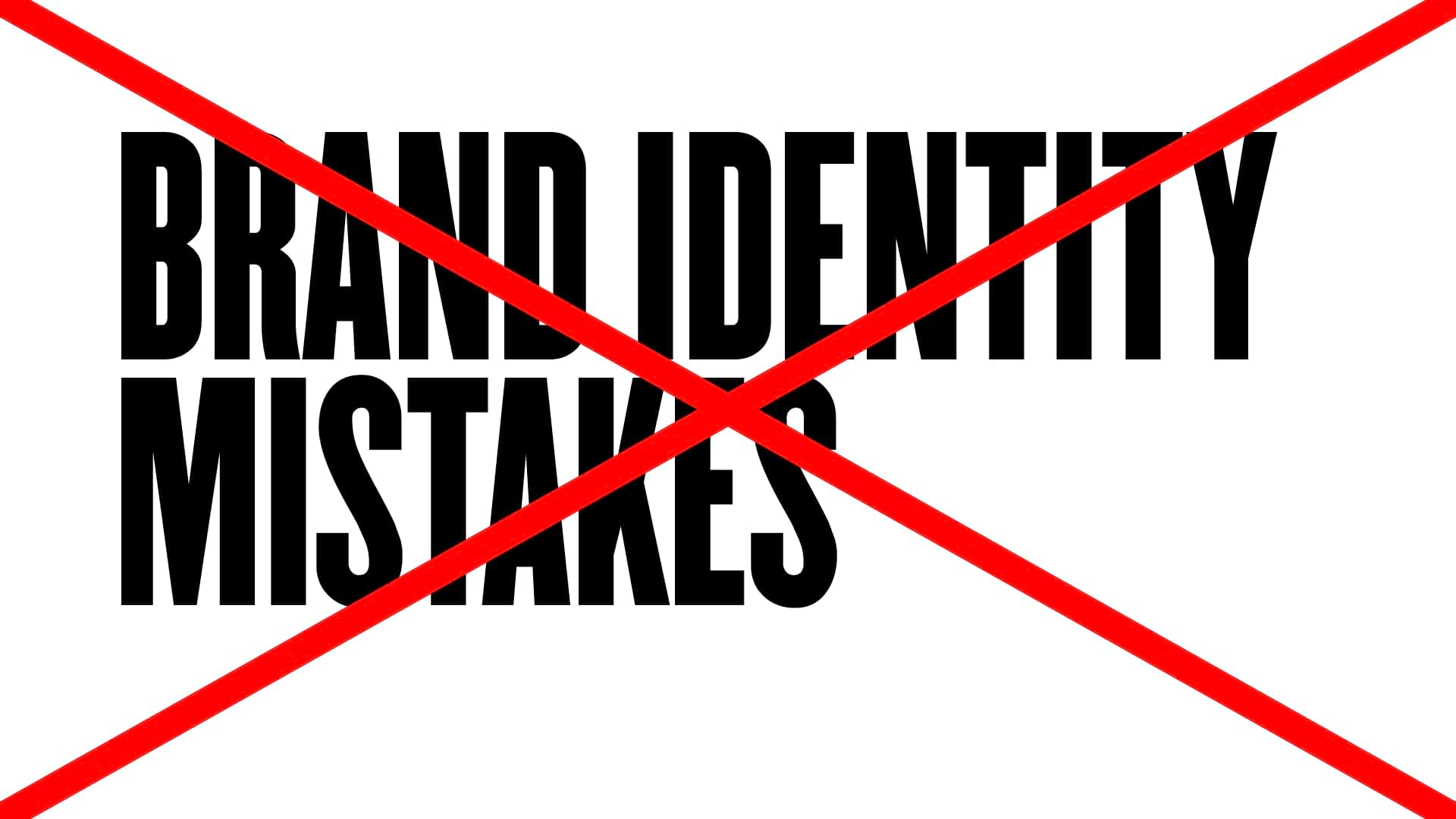Branding
Mastering Brand Identity: Avoid Common Mistakes and Boost Success for Startups and Businesses
09.02.2025
By Shaikh Asif

Branding
09.02.2025
By Shaikh Asif
Building a powerful brand identity is more than just a logo and a catchy tagline; it's about creating an emotional connection with your audience that drives growth and establishes authority. However, many businesses fall into common pitfalls that can derail their branding efforts. Here, we'll delve into these mistakes and provide actionable insights to help you build a brand identity that stands out and resonates with your target audience.
Pitfall: Jumping straight into design elements without a solid brand strategy.
Insight: Before you even think about colors and logos, you need a clear brand strategy. This includes understanding your target audience, defining your brand mission, vision, and values, and identifying your unique selling proposition (USP). A well-defined strategy serves as the foundation upon which all your branding efforts will be built.
Actionable Tip: Conduct thorough market research to understand your audience's needs, preferences, and pain points. Develop a brand strategy document that outlines your brand’s purpose, values, and positioning in the market.
Pitfall: Inconsistency in brand messaging across different platforms and channels.
Insight: Consistency in messaging is crucial for building trust and recognition. If your brand voice varies from one platform to another, it can confuse your audience and dilute your brand’s identity.
Actionable Tip: Create a brand style guide that includes your brand voice, tone, and key messaging. Ensure that everyone in your organization, from marketing to customer service, is aligned with this guide.
Pitfall: Underestimating the power of a cohesive visual identity.
Insight: Your visual identity – including your logo, color palette, typography, and imagery – plays a significant role in how your brand is perceived. A disjointed or unprofessional visual identity can undermine your brand’s credibility.
Actionable Tip: Invest in professional design services to create a cohesive visual identity. Use this visual language consistently across all touchpoints, from your website to social media profiles and marketing materials.

Pitfall: Overlooking the power of a memorable and meaningful tagline.
Insight: A strong tagline can encapsulate your brand’s essence in a few words and leave a lasting impression. It should convey your brand’s promise and differentiate you from competitors.
Actionable Tip: Develop a tagline that is clear, concise, and reflective of your brand’s core values and benefits. Test it with your audience to ensure it resonates and is easily memorable.
Pitfall: Sticking to outdated branding strategies and failing to adapt to market changes.
Insight: The market is constantly evolving, and your brand needs to evolve with it. Staying current with trends and being willing to adapt is key to maintaining relevance.
Actionable Tip: Regularly review your brand strategy and visual identity. Be open to making adjustments based on market trends, technological advancements, and feedback from your audience.
Pitfall: Focusing too much on product features and not enough on the brand story.
Insight: People connect with stories, not just products. Your brand story should highlight your journey, values, and the impact you want to make in the world.
Actionable Tip: Craft a compelling brand story that resonates with your audience’s emotions and aspirations. Share this story consistently across all your marketing channels.
Pitfall: Failing to utilize testimonials, reviews, and case studies effectively.
Insight: Social proof can significantly enhance your brand’s credibility and trustworthiness. Potential customers are more likely to trust the opinions of others who have had positive experiences with your brand.
Actionable Tip: Actively collect and showcase testimonials, reviews, and case studies on your website and social media channels. Encourage satisfied customers to share their experiences.
Pitfall: Overlooking the importance of delivering a seamless and positive customer experience.
Insight: Every interaction a customer has with your brand contributes to their overall perception. A poor customer experience can quickly tarnish your brand’s reputation.
Actionable Tip: Map out the customer journey and identify key touchpoints. Ensure that each interaction is designed to provide value and enhance the customer’s experience with your brand.
Pitfall: Neglecting your online presence and digital marketing efforts.
Insight: In today’s digital age, a strong online presence is crucial for brand visibility and engagement. Your website, social media profiles, and online content are often the first points of contact for potential customers.
Actionable Tip: Optimize your website for user experience and SEO. Develop a robust content marketing strategy that includes regular blog posts, social media updates, and email campaigns to engage with your audience.
Pitfall: Failing to track and analyze the performance of your branding efforts.
Insight: Without measuring the effectiveness of your branding strategies, you won’t know what’s working and what’s not. Data-driven insights are essential for continuous improvement.
Actionable Tip: Use tools like Google Analytics, social media analytics, and customer feedback to monitor your brand’s performance. Regularly review these metrics and adjust your strategies accordingly.
Understanding your target audience is crucial for developing a brand identity that resonates. Conduct market research to gather insights into their preferences, needs, and behaviors. Actionable Insight: Create detailed buyer personas that represent your ideal customers. These personas will guide your branding and marketing strategies.

Your UVP is what sets you apart from competitors. Clearly articulate what makes your brand unique and why customers should choose you over others. Best Practice: Highlight your UVP prominently in your marketing materials and ensure that it is communicated consistently across all channels.
Authenticity builds trust. Ensure that your brand identity reflects your true values and mission. Avoid mimicking competitors or chasing trends that don’t align with your core principles.
Example: TOMS Shoes built its brand around the mission of giving back. Their “One for One” model, where every purchase leads to a donation, is a core part of their authentic brand identity.
A polished, professional look can make a significant difference in how your brand is perceived. Invest in high-quality design for your logo, website, and marketing materials. Actionable Insight: Work with experienced designers or partner with dedicated agencies such as alitestar to create a cohesive visual identity that reflects your brand’s personality and values.
Your brand identity should evolve with your business and market trends. Regularly review and update your brand elements to ensure they remain relevant and effective.
Best Practice: Conduct brand audits periodically to assess the effectiveness of your brand identity and make necessary adjustments.

Consistency is key when it comes to brand identity. Ensure that all your marketing materials, from social media posts to email newsletters, convey a unified message. This consistency helps to build recognition and trust with your audience.
Actionable Insight: Develop a brand style guide that outlines your visual and verbal branding elements. This guide should be used by everyone involved in creating content for your brand to maintain uniformity.
Storytelling is a powerful tool in marketing. It allows you to connect with your audience on an emotional level. Share stories that highlight your brand’s values, mission, and the journey that got you to where you are today.
Example: Patagonia’s brand story revolves around environmental activism and sustainability. Their consistent storytelling around these themes has built a loyal customer base that aligns with these values.
Your brand should look and feel the same across all platforms. Whether a customer interacts with your brand on Instagram, your website, or in-store, they should have a cohesive experience.
Best Practice: Use the same color palette, typography, and design elements across all marketing channels. This visual consistency reinforces brand recognition.
Social proof, such as testimonials, reviews, and user-generated content, can significantly enhance your brand’s credibility. Encourage satisfied customers to share their experiences and showcase these endorsements in your marketing materials.
SEO Tip: Optimize user-generated content for SEO by encouraging customers to use specific keywords and phrases related to your brand and industry.

Active engagement with your audience builds a community around your brand. Respond to comments, participate in conversations, and show appreciation for your followers. This engagement humanizes your brand and fosters loyalty.
Actionable Insight: Host regular Q&A sessions or live streams on social media platforms to interact directly with your audience. This not only boosts engagement but also provides valuable insights into customer preferences and pain points.
Content is king, but quality is queen. Produce high-quality, valuable content that resonates with your target audience. This can be in the form of blog posts, videos, infographics, or podcasts. Quality content not only drives traffic but also positions your brand as an authority in your industry.
SEO Tip: Incorporate relevant keywords naturally into your content to improve search engine rankings. Tools like Google Keyword Planner can help you identify the best keywords to target.
7. Personalization
Personalization in marketing is no longer a luxury; it’s a necessity. Tailor your marketing messages to individual preferences and behaviors to create a more personalized experience.
Example: Netflix’s recommendation system personalizes content suggestions based on user viewing history, creating a more engaging and tailored experience for each user.
In conclusion, a robust brand identity is indispensable for businesses and startups aiming for significant growth and authority in their industry. It differentiates you from competitors, builds trust and emotional connections, attracts your ideal customers, and enhances brand recall. By defining a clear brand strategy, investing in professional design, and maintaining consistency, you can create a powerful brand identity that drives long-term success. Start building your brand identity today, and watch as it transforms your business into a recognizable, trusted, and beloved entity in the market.
Leveraging a strong brand identity in your marketing efforts is essential for driving growth and establishing authority in your industry. By maintaining consistency, engaging in authentic storytelling, and focusing on quality content, you can create a powerful brand that resonates with your audience and stands out in the crowded marketplace. Remember, your brand identity is the foundation of your marketing strategy—invest in it wisely and watch your business thrive. By implementing these strategies and best practices, you can harness the full potential of your brand identity, leading to more effective marketing campaigns and significant business growth. Stay true to your brand, understand your audience, and consistently deliver value to build a brand that not only attracts but also retains loyal customers.


Shaikh Asif is an Award-winning designer, director, strategist, and educator. He’s the Lead Strategic Brand Designer and Art Director of The Alitestar— a strategic branding and design agency that helps startups, ambitious CEOs, and passionate entrepreneurs to achieve success and ultimately create unforgettable brand experiences.